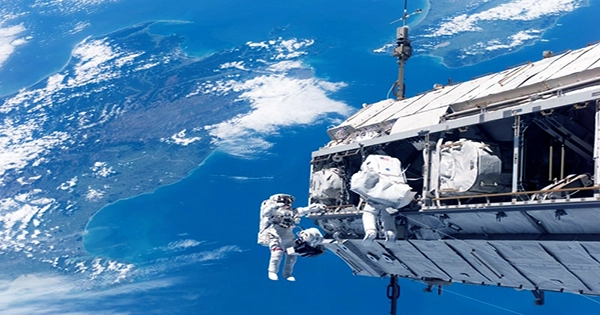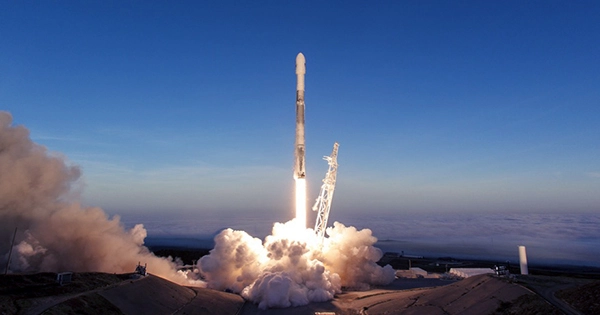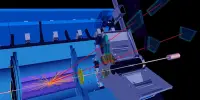Friday at 5:48 p.m. EST (2221 GMT), SpaceX launched a Falcon 9 rocket from Cape Canaveral on a mission to lift two powerful broadband satellites for SES’s O3b mPOWER network into an unusual equatorial orbit 5,000 miles above the planet.
The first two O3b mPOWER satellites will be put into orbit by a Falcon 9 rocket from Florida’s Space Coast, joining SES’s 20 first-generation O3b internet satellites that were deployed from 2013 to 2019.
More than 90% of the time, the 45th Weather Squadron of the U.S. Space Force predicts ideal conditions for launch, with just a slender likelihood of dense clouds that could pose a lightning threat. The first stage booster of the Falcon 9 is scheduled to land on SpaceX’s drone ship “A Shortfall of Gravitas” in the Atlantic Ocean under ideal weather conditions, roughly 420 miles (670 kilometers) east of Cape Canaveral.
A million pounds of liquid oxygen and kerosene propellants will be added to the Falcon 9 rocket during the last 35 minutes of Friday’s countdown.

The nine Merlin 1D main engines on the first stage booster will flash to life with the aid of an igniting fluid called triethylaluminum/triethyl borane, or TEA-TEB, once teams confirm all technical and meteorological criteria are “green” for launch. Hydraulic clamps will open to release the Falcon 9 for its ascent into space once the engines reach full power.
The Falcon 9 and the two O3b mPOWER satellites will be propelled into the upper atmosphere by the nine main engines, which will provide 1.7 million pounds of thrust for around two and a half minutes. The booster stage will then shut down and detach from the upper stage of the Falcon 9 at tail number B1067 in SpaceX’s fleet.
In order to position itself for a tail-first return entry into the atmosphere, the booster will extend titanium grid fins and pulse cold gas thrusters. The booster will then relight its engines for a braking burn and a final landing burn, targeting a vertical descent to the drone ship holding position in the Atlantic Ocean.
The first stage booster of the Falcon 9 is scheduled to land on SpaceX’s drone ship “A Shortfall of Gravitas” in the Atlantic Ocean under ideal weather conditions, roughly 420 miles (670 kilometers) east of Cape Canaveral.
A million pounds of liquid oxygen and kerosene propellants will be added to the Falcon 9 rocket during the last 35 minutes of Friday’s countdown.
The nine Merlin 1D main engines on the first stage booster will flash to life with the aid of an igniting fluid called triethylaluminum/triethyl borane, or TEA-TEB, once teams confirm all technical and meteorological criteria are “green” for launch. Hydraulic clamps will open to release the Falcon 9 for its ascent into space once the engines reach full power.
In order to place the two Boeing-built broadband satellites closer to their final operating altitude of 5,000 miles (8,000 kilometers) over the equator for the O3b mission, the Falcon 9’s upper stage will fire its engine three times.
One hour and 53 minutes into the mission, the first O3b mPOWER satellite will separate from the rocket, followed two hours later by the separation of the second spacecraft. According to SES, the Luxembourg-based corporation that owns the O3b network, the satellites will deploy their solar panels and turn on xenon-fueled engines to navigate into their operational orbit, a procedure that will take until around April.
According to a Boeing representative speaking to Spaceflight Now, the combined weight of the two O3b spacecraft is about 9,000 pounds (4,100 kilograms) in launch mode.
According to SES, the Luxembourg-based operator that controls the O3b fleet, the O3b mPOWER satellites will beam high-speed internet services over the globe, offering “fiber-like” connectivity to users between 50 degrees north and south latitude.
20 O3b satellites from SES are already in MEO. As part of an agreement with Arianepace for launch services, they traveled to space on Russian Soyuz rockets.
The original O3b satellites’ Medium Earth Orbit, or MEO, over the equator will be replicated by the new O3b mPOWER satellites.
The O3b mPOWER system from SES, according to Ruy Pinto, chief technology officer of SES, “is a true gamechanger and will redefine the way people think about connectivity.” “O3b mPOWER will provide connectivity services to businesses and government agencies located in even the most remote areas, prioritizing performance above all else. When networks go down due to natural disasters, O3b mPOWER’s low-latency services can be used to quickly restore crucial communications networks.
Ten user beams were included in each of the first O3b satellites, which Thales Alenia Space constructed almost ten years ago. Built on Boeing’s 702 spacecraft platform, the new O3b mPOWER satellites each have more than 4,000 beams that can be modified to concentrate bandwidth on locations with high demand.
The MEO constellation places the relay stations closer to Earth than the geostationary orbit, which is 22,000 miles above the earth. SES has concentrated on constructing broadband satellites for this constellation. As a result, internet transmissions have less latency than signals from geostationary satellites. Global coverage might be achieved with as few as three geostationary satellites, but more MEO satellites are needed to cover the entire planet.
However, that number is still significantly lower than the hundreds or thousands of internet satellites being launched into low Earth orbit by organizations like SpaceX and OneWeb. Even more than MEO satellites, LEO satellites reduce latency, although a much larger number of spacecraft are required for worldwide coverage.
Eleven O3b mPOWER satellites will be constructed by Boeing. In 2023, further O3b mPOWER payloads are planned to fly on Falcon 9 rockets.
O3b, short for “Other 3 Billion,” refers to the enormous number of people who do not have access to dependable internet service.
According to Jim Chilton, senior vice president of space and launch at Boeing, “SES contacted us with a goal to promote global equity, by giving people with high-speed access where it wasn’t physically or economically feasible to install fiber infrastructure.” “To achieve that goal, we collaborated to build a supercomputer constellation in space, and we can’t wait to see what SES does as the 702X platform’s initial user.”
















